初中英语语法知识—陈述句的知识点(1)
初中英语语法知识—陈述句的技巧及练习题(1)
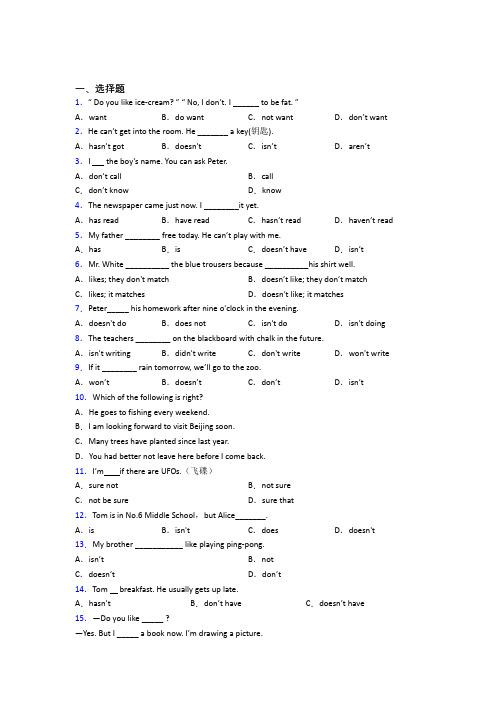
一、选择题1.“ Do you like ice-cream? ” “ No, I don’t. I ______ to be fat. ”A.want B.do want C.not want D.don’t want 2.He can’t get into the room. He _______ a key(钥匙).A.hasn’t got B.doesn't C.isn’t D.aren’t3.I the boy’s name. You can ask Peter.A.don’t call B.callC.don’t know D.know4.The newspaper came just now. I ________it yet.A.has read B.have read C.hasn’t read D.haven’t read 5.My father ________ free today. He can’t play with me.A.has B.is C.doesn’t have D.isn’t 6.Mr. White __________ the blue trousers because __________his shirt well. A.likes; they don't match B.doesn’t like; they don’t match C.likes; it matches D.doesn't like; it matches7.Peter_____ his homework after nine o'clock in the evening.A.doesn't do B.does not C.isn't do D.isn't doing 8.The teachers ________ on the blackboard with chalk in the future.A.isn't writing B.didn't write C.don't write D.won't write 9.If it ________ rain tomorrow, we’ll go to the zoo.A.won’t B.doesn’t C.don’t D.isn’t 10.Which of the following is right?A.He goes to fishing every weekend.B.I am looking forward to visit Beijing soon.C.Many trees have planted since last year.D.You had better not leave here before I come back.11.I’m if there are UFOs.(飞碟)A.sure not B.not sureC.not be sure D.sure that12.Tom is in No.6 Middle School,but Alice_______.A.is B.isn't C.does D.doesn't 13.My brother ___________ like playing ping-pong.A.isn’t B.notC.doesn’t D.don’t14.Tom breakfast. He usually gets up late.A.hasn’t B.don’t have C.doesn’t ha ve 15.—Do you like _____ ?—Yes. But I _____ a book now. I’m drawing a picture.A.read;reading B.read;am not readingC.reading;am reading D.reading; am not reading16.Your name again? I'm sorry I catch it.A.don't B.didn't C.won't D.wasn't17.I ________ math but I like English.A.like B.likes C.doesn’t like D.don’t like 18.No man is really happy or safe without a hobby. Even though you are rather busy every day, you should find time for your hobbies because they can _____.①not help you find new ways of thinking②make you feel more confident③help you relax after a long time of hard work④make you feel more lonely⑤help you learn something newA.①③⑤B.②④⑤C.②③⑤19.I______ Jack ______ go to the cinema with you tonight. He always watches films with me. A.think; won'tB.don't think; isC.don't think; willD.think; isn't going to20.Which of the following sentences is the Opinion?A.J.K. Rowling is one of the greatest writers in the world.B.Harry Potter series has been translated into about 70 languages.C.J.K. Rowling got the idea of the story on the train trip to London.D.There are seven books in the series of the story.21.Which following sentences is the Opinion?A.There are 7 books in the series of the story.B.Harry Potter series has been translated into about 70 languages.C.J.K. Rowling got the idea of the story on the train trip to London.D.J.K. Rowling is one of the greatest writers in the world.22.If it _________ rainy tomorrow, we will go for an outing.A.doesn't B.will be C.is D.isn't23.— Whose coat is this? Is it Cindy's?—It _______________be hers. Don't you remember she didn't come to the picnic?A.can't B.might C.must24.Students are___________ to speak loudly in the reading room.A.told B.supposed C.not supposed D.allowed 25.—What are those? —_______.A.They are books. B.She is my sisterC.They are my brothers D.It is a dictionary【参考答案】***试卷处理标记,请不要删除一、选择题1.D解析:D【解析】试题分析:句意:-你喜欢冰淇淋吗?-不,我不喜欢。
【初中英语】初中英语语法大全之陈述句
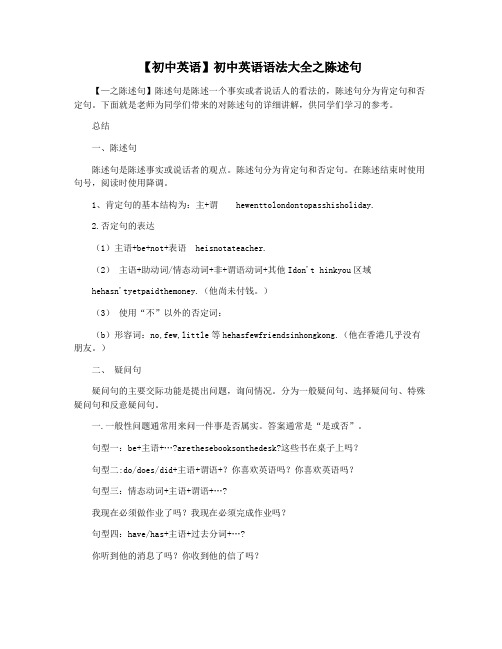
【初中英语】初中英语语法大全之陈述句【—之陈述句】陈述句是陈述一个事实或者说话人的看法的,陈述句分为肯定句和否定句。
下面就是老师为同学们带来的对陈述句的详细讲解,供同学们学习的参考。
总结一、陈述句陈述句是陈述事实或说话者的观点。
陈述句分为肯定句和否定句。
在陈述结束时使用句号,阅读时使用降调。
1、肯定句的基本结构为:主+谓hewenttolondontopasshisholiday.2.否定句的表达(1)主语+be+not+表语heisnotateacher.(2)主语+助动词/情态动词+非+谓语动词+其他Idon't hinkyou区域hehasn'tyetpaidthemoney.(他尚未付钱。
)(3)使用“不”以外的否定词:(b)形容词:no,few,little等hehasfewfriendsinhongkong.(他在香港几乎没有朋友。
)二、疑问句疑问句的主要交际功能是提出问题,询问情况。
分为一般疑问句、选择疑问句、特殊疑问句和反意疑问句。
一.一般性问题通常用来问一件事是否属实。
答案通常是“是或否”。
句型一:be+主语+…?arethesebooksonthedesk?这些书在桌子上吗?句型二:do/does/did+主语+谓语+?你喜欢英语吗?你喜欢英语吗?句型三:情态动词+主语+谓语+…?我现在必须做作业了吗?我现在必须完成作业吗?句型四:have/has+主语+过去分词+…?你听到他的消息了吗?你收到他的信了吗?另外,还有以be动词、助动词或情态动词的否定缩写形式开头的一般疑问句,这种句子一般表示请求、惊讶和对事物的看法等,回答时所用的yes和no表达的意思和汉语的习惯不同。
例如;--isn'thetall?难道他不高吗?--是的,你好。
不,他很高。
2、特殊疑问句以疑问词开头,对句中某一成分提问的句子叫特殊疑问句。
常用的疑问词有:what、who、whose、which、when、where、how、why等。
九年义务初中英语陈述句全部重要知识点

1.陈述句是用来陈述或表达事实、观点、情况或动作的句子类型。
2.陈述句的结构通常为主语+谓语+宾语(如果有的话)。
3. 陈述句的动词谓语通常使用一般现在时态来表示经常性或普遍性
的情况,如"I go to school every day."(我每天去上学)。
4. 陈述句中的主语和谓语必须在人称和数上保持一致,例如"She eats dinner at 6 p.m."(她在晚上六点吃晚餐)。
5.在陈述句中,助动词和情态动词经常用来表示时态、语态、否定或
疑问等语法功能。
7. 陈述句也可以使用具体的地点副词或方式副词来进一步描述动作
的发生地点或方式,如:in the park(在公园里),quickly(快速地)等。
8. 陈述句中的实义动词可以加上不定式、现在分词或过去分词形式
来表达不同的意义或完成动作的时间,如:I want to go to the movies.(我想去看电影)。
9. 陈述句中的具体细节可以通过添加形容词或副词来提供更多信息,以增强句子的描述力,如:He is a tall and handsome boy.(他是一个
高大帅气的男孩)。
10. 陈述句中常用的连词包括and(和)、but(但是)、or(或者),用于连接并列或选择关系的主语、谓语、宾语或状语等。
语法小知识:陈述句的概念解析

语法小知识:陈述句的概念解析
陈述句是我们学习语法的入门知识,是最开始接触的最基础的内容,很多人觉得陈述句简单便忽略了它,但实际上很多人英语学到了高级阶段,却连最简单的也造不出来,所以陈述句千万不能忽略。
一.定义
陈述句用来叙述一个事实,句末标点用句号。
有的陈述句表求肯定的意思,在说话、写文章中,对陈述语气的要求是多方面的,只会简单肯定和否定,不能满足表情达意的需要。
因此,陈述句又分为肯定的陈述句和否定的陈述句,简称为肯定句(TheAffirmativeSentence)和否定句(TheNegativeSentence)。
二.基本句型
1、主语+连系动词+表语
2、主语+谓语(不及物动词)
3、主语+谓语(及物动词)+宾语
4、主语+谓语(及物动词)+间接宾语+直接宾语
5、主语+谓语(及物动词)+宾语+宾语补足语
三.分类
肯定句:在说话、写文章中,表示肯定的句子。
否定句:在说话、写文章中,表示否定的句子。
①.一般否定句:即含有“不、没有、完全不是,完全不”等否定意思的词的句子。
②.双重否定句:含有两个否定词的句子,例如:含有“没有.....不......”“,非.....不可......”等的句子,双重否定句表示肯定。
七年级陈述句知识点总结
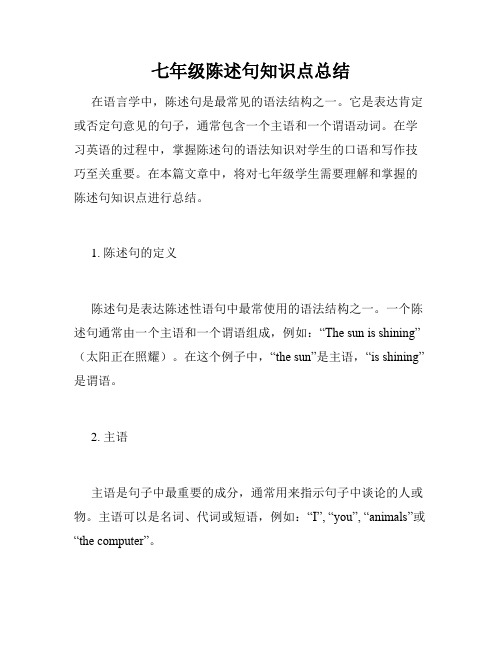
七年级陈述句知识点总结在语言学中,陈述句是最常见的语法结构之一。
它是表达肯定或否定句意见的句子,通常包含一个主语和一个谓语动词。
在学习英语的过程中,掌握陈述句的语法知识对学生的口语和写作技巧至关重要。
在本篇文章中,将对七年级学生需要理解和掌握的陈述句知识点进行总结。
1. 陈述句的定义陈述句是表达陈述性语句中最常使用的语法结构之一。
一个陈述句通常由一个主语和一个谓语组成,例如:“The sun is shining”(太阳正在照耀)。
在这个例子中,“the sun”是主语,“is shining”是谓语。
2. 主语主语是句子中最重要的成分,通常用来指示句子中谈论的人或物。
主语可以是名词、代词或短语,例如:“I”, “you”, “animals”或“the computer”。
3. 谓语谓语是指主语所做的行为或所受的动作。
它通常由一个动词构成,例如:“runs”, “is eating”, “swam”。
在英语中,谓语的形式可以发生变化,以表示时态、语态、人称和数。
例如,“I run”可以变成“he runs”或“she runs”。
4. 动词时态动词时态是表示发生时间的形式。
在英语中,常见的时态包括现在时、过去时和将来时。
在使用不同时态时,需要根据句子的情境来选择正确的时态。
例如,“I am eating dinner now”(我现在正在吃饭)是现在时,而“I ate dinner last night”(我昨晚吃了晚饭)则是过去时。
5. 动词语态动词语态是表示句子中主语做出的动作或接受的动作的形式。
英语中有两种语态:主动语态和被动语态。
主动语态表示主语做出动作,如“the dog is chasing the cat”(狗在追猫)。
而被动语态表示主语接受动作,如“the cat was chased by the dog”(猫被狗追了)。
6. 句子成分在陈述句中,还有一些其他的成分,如宾语、定语和副词。
初中英语知识点:陈述句和疑问句

中考英语陈述句和疑问句用法一、基本概念陈述句是陈述一个事实或者说话人的看法。
它包括肯定句和否定句两种。
陈述句在书写时句末用句号,在朗读时用降调。
疑问句是用来提问的句子,句末用问号。
疑问句分为一般疑问句,特殊疑问句,选择疑问句和反义疑问句。
二、基本分类陈述句肯定句疑问句一般疑问句特殊疑问句选择疑问句否定句反义疑问句三、用法详解1、否定句1)一看句中是否有be 动词(am,is are,was,were),如果有在其后加not, 并把原句中的some 改为any。
例如:She is reading a book.---She is not reading a book.There are some apples on the tree.—There are not any (=no ) apples on the tree.2)二看句中是否有情态动词:(can ,could, may, must, will, would, should等)变化如同一中说,not 仍然放在后。
例如:I can ride a bike.---I can not (=can’t) ride a book.We will hold a sports meeting next Sunday.----We will not (=won’t) hold a sports meeting next Sunday.3)三看句中是否有助动词:(have, has, had),变化如同前两说,not仍然放其后。
例如:We have finished the task.----We haven’t finished the task.4)四变否定却看无,句中只有行为动(词),要提助动来完成。
(don’t, doesn’t, didn’t)例如:(1)I want a new bike.--I don’t want a new bike.(2)He wrote a letter to his pen-friend yesterday.--He didn’t write a letter to his pen-friend yesterday.(3)She always takes good care of her patients. --She doesn’t always take good care of her patients.当借助doesn’t和didn’t 构成否定后,行为动词要还原为原形。
陈述句知识点归纳

陈述句知识点归纳陈述句是一种用来陈述事实、表达观点或提出问题的句子。
它是语言表达中最常见、最基本的句子类型之一。
下面列举了一些陈述句的知识点。
1. 陈述句的基本结构是主语+谓语+宾语。
主语通常是句子中起主导作用的人或事物,谓语是对主语的陈述或描述,宾语是动作的承受者或行为的对象。
2. 陈述句可以用来陈述事实、描述现象、表达观点等。
它是表达思想和交流信息的基本工具。
3. 陈述句可以使用不同的时态来表示动作发生的时间。
常见的时态有一般现在时、一般过去时、一般将来时等。
4. 陈述句可以使用不同的语气来表达说话人的态度。
常见的语气有陈述语气、祈使语气、疑问语气等。
5. 陈述句可以使用不同的修饰词来增强句子的表达力。
修饰词可以是形容词、副词、介词短语等。
6. 陈述句可以使用不同的句式来表达不同的语言目的。
常见的句式有简单句、复合句、并列句等。
7. 陈述句可以使用不同的连接词来连接句子和段落。
连接词可以是并列连词、递进连词、转折连词等。
8. 陈述句可以使用不同的语法结构来表达不同的句意。
常见的语法结构有被动语态、倒装句、虚拟语气等。
9. 陈述句可以使用不同的修辞手法来增强句子的表达效果。
修辞手法可以是比喻、拟人、夸张等。
10. 陈述句可以使用不同的句子成分来组织句子结构。
常见的句子成分有主语、谓语、宾语、定语、状语等。
11. 陈述句可以使用不同的句子长度和节奏来表达句子的节奏感。
长句和短句的搭配可以使句子更加生动有力。
总结:陈述句是语言交流中最基本的句子类型之一。
它通过主语、谓语和宾语的组合来陈述事实、表达观点或提出问题。
陈述句可以使用不同的时态、语气、修饰词、句式、连接词、语法结构、修辞手法、句子成分、句子长度和节奏等来增强句子的表达力和表达效果。
掌握陈述句的知识点可以帮助我们更好地理解和运用语言,提高语言表达能力。
最新初中英语语法知识—陈述句的解析(1)

一、选择题1.Your name again? I'm sorry I catch it.A.don't B.didn't C.won't D.wasn't2.Li Ming ______ volleyball. He only watch it on TV.A.plays B.doesn’t play C.watches D.doesn’t watch 3.I the boy’s name. You can ask Peter.A.don’t call B.callC.don’t know D.know4.His mother ____ him ____ the games.A. is allowed , to play B.doesn’t allow , to playC.doesn’t allow play D.is allowed play5.The teachers ________ on the blackboard with chalk in the future.A.isn't writing B.didn't write C.don't write D.won't write 6.She a volleyball.A.have B.don’t haveC.doesn’t have D.doesn’t has7.—What are those? —_______.A.They are books. B.She is my sisterC.They are my brothers D.It is a dictionary8.I __________ news. They are boring.A.can’t stand B.like C.love D.don’t mind 9.—Don’t forget _____________ the letter on your way home.—OK, I _____________.A.to send; will B.sending; will C.to send; won’t D.sending; won’t 10.I _______ I ________ going to stay at home.A.don’t think, am B.not think ,amC.think, am not D.no think, am11.If you don’t go to the concert this weekend, ________.A.I will, too. B.I won’t, either.C.I do, too. D.I don’t, either.12.He can’t get into the room. He _______ a key(钥匙).A.hasn’t got B.doesn't C.isn’t D.aren’t 13.Susan and her classmates__________ to the mountain last week.A.don’t go B.didn’t goC.isn’t going D.aren’t going14.—Daniel, why are you late again? The movie _______ 15 minutes ago!—Sorry, I _____ to. I was trapped (困住) in the subway.A.starts; mean B.started; meantC.started; didn’t mean D.starts; don’t mean15.Which of the following sentences is correct?A.I will call you. As soon as I arrive in Beijing.B.Jenny said: “I enjoyed dancing to light music.”C.Norman Bethune is one of the most famous heroes in China.D.Although she was tired, but Tina still helped me finish the task.16.—Oh, the room is too dirty, Tony!—Sorry, Mom. It yesterday. I forgot to do it.A.didn’t clean B.isn’t cleanedC.was cleaned D.wasn’t cleaned17.I’m f ine, but my sister .A.doesn’t B.isn’t C.is D.not 18.Paul is crazy about basketball, but he ______ football very often.A.doesn’t play B.isn’t playingC.didn’t play D.won’t play19.I ________ math but I like English.A.like B.likes C.doesn’t like D.don’t like 20.Which of the following sentences is the Opinion?A.J.K. Rowling is one of the greatest writers in the world.B.Harry Potter series has been translated into about 70 languages.C.J.K. Rowling got the idea of the story on the train trip to London.D.There are seven books in the series of the story.21.---What are you going to do next weekend?---I _____ yet. Do you have any good ideas?A.haven't decided B.won't decideC.have decided D.didn't decide22.You _____buy anything else. We have got everything ready for the party. A.don't need to B.needn't to C.don't need D.need 23.You’d better ____________ late next time.A.not be B.not to be C.won’t be D.don’t be 24.-Excuse me. I can't enter the museum. Could you help me?-Sorry, the museum __________ today. It will be open tomorrow.A.doesn't open B.hasn't opened C.open D.opens 25.She ___________ clean the classroom today.A.isn’t have to B.don’t have toC.doesn’t have to D.have to【参考答案】***试卷处理标记,请不要删除一、选择题1.B解析:B【解析】【分析】【详解】句意:再说一下你的名字?对不起,我没听清。
初中英语语法总结陈述句
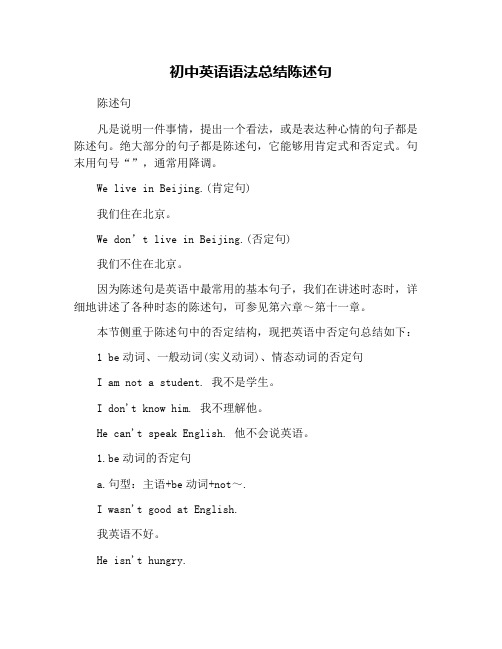
初中英语语法总结陈述句陈述句凡是说明一件事情,提出一个看法,或是表达种心情的句子都是陈述句。
绝大部分的句子都是陈述句,它能够用肯定式和否定式。
句末用句号“”,通常用降调。
We live in Beijing.(肯定句)我们住在北京。
We don’t live in Beijing.(否定句)我们不住在北京。
因为陈述句是英语中最常用的基本句子,我们在讲述时态时,详细地讲述了各种时态的陈述句,可参见第六章~第十一章。
本节侧重于陈述句中的否定结构,现把英语中否定句总结如下:1 be动词、一般动词(实义动词)、情态动词的否定句I am not a student. 我不是学生。
I don't know him. 我不理解他。
He can't speak English. 他不会说英语。
1.be动词的否定句a.句型:主语+be动词+not~.I wasn't good at English.我英语不好。
He isn't hungry.他不饿。
b.实行时和被动语态(现在时、过去时、实行时)都有be动词,所以它们的否定句与be动词的否定句同形。
(详见第十三章被动语态)They aren't cleaning the room.(现在实行时)他们没在打扫房间。
The child was not looked after.(过去时的被动语态)这个孩子以前没有被照顾过。
c.将来时(will,shall)、完成时及情态动词的被动语态不能用be 动词的否定句型。
(○) They will not be sent to the fro nt.(×)They will be not sent to the front.他们将不会被送到前线。
2.情态动词的否定句句型:主语+情态动词+ not +动词原形(详见第十二章中的“情态动词”部分)I cannot do it myself.我自己做不了这件事。
初中英语陈述句讲解
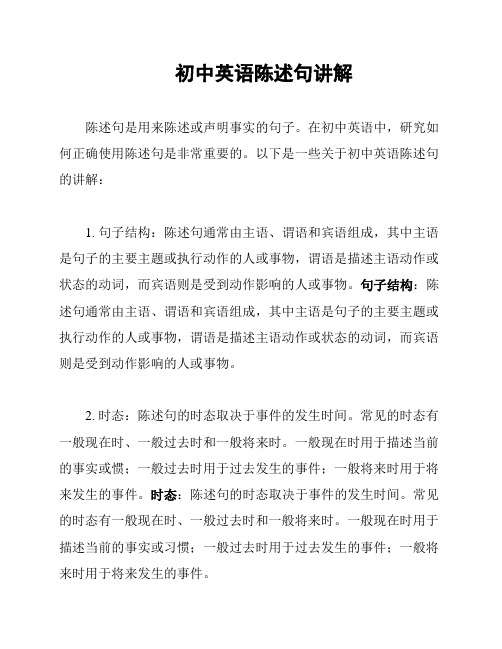
初中英语陈述句讲解陈述句是用来陈述或声明事实的句子。
在初中英语中,研究如何正确使用陈述句是非常重要的。
以下是一些关于初中英语陈述句的讲解:1. 句子结构:陈述句通常由主语、谓语和宾语组成,其中主语是句子的主要主题或执行动作的人或事物,谓语是描述主语动作或状态的动词,而宾语则是受到动作影响的人或事物。
句子结构:陈述句通常由主语、谓语和宾语组成,其中主语是句子的主要主题或执行动作的人或事物,谓语是描述主语动作或状态的动词,而宾语则是受到动作影响的人或事物。
2. 时态:陈述句的时态取决于事件的发生时间。
常见的时态有一般现在时、一般过去时和一般将来时。
一般现在时用于描述当前的事实或惯;一般过去时用于过去发生的事件;一般将来时用于将来发生的事件。
时态:陈述句的时态取决于事件的发生时间。
常见的时态有一般现在时、一般过去时和一般将来时。
一般现在时用于描述当前的事实或习惯;一般过去时用于过去发生的事件;一般将来时用于将来发生的事件。
3. 主谓一致:在陈述句中,主语和谓语在人称和数上要保持一致。
当主语是第三人称单数(he、she、it)时,谓语动词要加上-s 或-es。
主谓一致:在陈述句中,主语和谓语在人称和数上要保持一致。
当主语是第三人称单数(he、she、it)时,谓语动词要加上-s 或-es。
4. 使用形容词和副词:陈述句中可以使用形容词描述主语的特征和属性。
副词则用于修饰动词、形容词或其他副词。
使用形容词和副词:陈述句中可以使用形容词描述主语的特征和属性。
副词则用于修饰动词、形容词或其他副词。
以下是一些例子:- 我去年买了一辆新自行车。
- The sun rises in the east.- She is a talented singer.- They will visit their grandparents this weekend.在写陈述句时,请确保句子结构正确、时态准确,并注意主谓一致和适当使用形容词和副词。
英语.陈述句
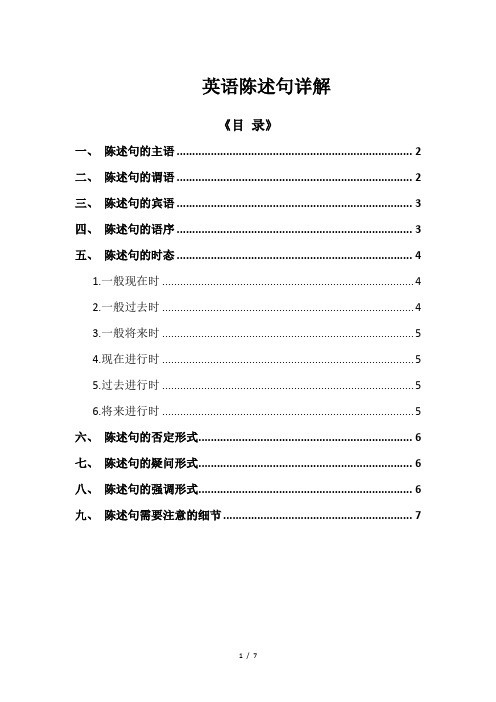
英语陈述句详解《目录》一、陈述句的主语 (2)二、陈述句的谓语 (2)三、陈述句的宾语 (3)四、陈述句的语序 (3)五、陈述句的时态 (4)1.一般现在时 (4)2.一般过去时 (4)3.一般将来时 (5)4.现在进行时 (5)5.过去进行时 (5)6.将来进行时 (5)六、陈述句的否定形式 (6)七、陈述句的疑问形式 (6)八、陈述句的强调形式 (6)九、陈述句需要注意的细节 (7)英语陈述句详解陈述句是最基本的语句类型之一,它用来陈述或描述一个事实、观点、情况、状态或事件。
在英语中,陈述句通常由主语、谓语和宾语组成,而且它们的顺序通常是主语在前、谓语在中、宾语在后。
一、陈述句的主语主语是陈述句的主要组成部分,它是一个名词、代词或名词短语,用来指代或描述陈述句所涉及的主体。
例如:John is a teacher.(约翰是一名教师。
)在这个例子中,“John”就是主语,它指代了这个陈述句所描述的主体,即“一名教师”。
除了名词或代词,主语也可以是名词短语,例如:The book on the table is mine.(桌子上的书是我的。
)在这个例子中,“The book on the table”就是主语,它是一个名词短语,用来描述陈述句所涉及的主体。
二、陈述句的谓语谓语是陈述句的另一个重要组成部分,它是一个动词或动词短语,用来描述或说明主语的动作、状态或情况。
例如:Mary is reading a book.(玛丽正在读一本书。
)在这个例子中,“is reading”就是谓语,它是一个动词短语,用来描述主语“Mary”的动作。
除了动词或动词短语,谓语也可以包括助动词、情态动词或句子中的其他词汇。
例如:I can speak English.(我会说英语。
)在这个例子中,“can speak”就是谓语,它由情态动词“can”和动词“speak”组成,用来描述主语“我”的能力。
三、陈述句的宾语宾语是陈述句的第三个组成部分,它是一个名词、代词或名词短语,用来指代或描述陈述句中的客体或受事者。
英语中的陈述句知识讲解

英语中的陈述句一、陈述句1. 陈述句的定义陈述句主要是用来传递信息,提供情况(包括肯定和否定的情况)。
China is the largest country in Asia. 中国是亚洲最大的国家。
I didn't tell him anything. 我什么也没有告诉他。
2. 肯定和否定的陈述句I'm going to see a film. 我打算去看电影。
I'm not going to see a film. 我不打算去看电影。
She has arrived. 她已经到达。
She hasn't arrived yet. 她还没有到达。
3. 其他否定的陈述句一、对谓语动词否定否定词除了not之外,还有never, hardly, scarcely, seldom, rarely(几乎不、很少)。
He never smokes cigarette. 他从不抽烟。
I hardly know the people there. 我几乎不认识那里的人。
二、对名词或代词否定No students will take the course. 没有学生会选修这门课。
I can do nothing about it. 对这事我无能为力。
Nobody will agree to this project. 没有人会同意这项计划。
4. 委婉陈述人们在陈述事实的时候,为了礼貌或者为了在说话时留有余地,常常在说话时采用委婉陈述方式。
一、采用插入语来软化陈述句的口气That will be, I think, too much for him. 我想那会使他受不了的。
You'll be caught in the rain,I'm afraid. 恐怕你们会淋雨。
I'll have another cup, if you please. 我想再来一杯,好吗?If you don't mind, I'd like to think about it for a minute.如果你不介意的话,容我考虑一下。
陈述句的解释英语知识

陈述句的解释英语知识
陈述句是英语语法中的一种句子类型,本文将对陈述句的定义、结构和使用进行解释。
陈述句是英语语法中最基本、最常用的句子类型之一。
它用于陈述或表达事实、观点、意见、感受等内容,不带任何疑问、命令或感叹的语气。
陈述句通常由主语和谓语构成,其中主语指代句子中的主要人、物或概念,而谓语则表示主语的动作、状态或属性。
陈述句的结构相对固定,一般遵循主语+谓语的顺序。
主语通常是名词、代词或名词短语,并且与谓语在人称、数和时态上保持一致。
谓语可以是动词、形容词、副词或其他带有表语功能的词组,用来描述或说明主语所表达的内容。
陈述句中可以使用各种不同的句子成分来修饰主语或谓语,如宾语、定语、状语等。
陈述句的使用非常广泛,几乎在我们日常生活中随处可见。
无论是书面语还是口语,陈述句都是最常用的句子类型。
我们可以用陈述句来描述事实、表达观点、提供信息或进行交流。
在英语交流中,正确使用陈述句可以使我们的语言更加准确、清晰,减少歧义,增强语言的表达力。
为了使陈述句更加准确、有说服力,我们可以运用一些语法结构和修辞手法。
例如,使用连词或副词来连接句子,使句子之间的关系更加紧密;使用形容词和副词来丰富句子的描述内容;使用修饰语来增添细节和信息等。
此外,我们还可以使用各种时态和语态来表达不
同的时间、态度和语气。
总之,陈述句是英语语法中最基本、最常用的句子类型之一。
它以客观、准确的方式陈述事实、观点和感受,用于日常交流和书面表达。
初中英语知识点汇总:陈述句、疑问句、祈使句、感叹句

初中英语知识点汇总:陈述句、疑问句、祈使句、感叹句句子的类型(一)教学重点句子的类型:陈述句陈述句(包括肯定的或否定的)用来叙述一项事实。
陈述句的结构分为肯定结构和否定结构两种。
1、陈述句的肯定结构(1)主语与谓语的一致,句子中的谓语动词和主语在人称和数上必须一致。
如:I was having dinner when he came in.He is now working at a bank.①谓语只跟主语的中心词保持一致,修饰词不影响主语的数:The quality of this kind of bike is poor.There be结构和其他倒装句中,谓语通常放在主语的前面,这时谓语是单数还是复数,要依后面的主语而定,如:There is no milk in the bottle.There are no students iin the classroom.②“one of ……”结构作主语,谓语应该用单数。
如:One of the students is absent.Making things is a good activity.What hurt her most is his words.③由and连接两个或两个以上的名词,由“both…and…”连接的两个成分作主语,其谓语动词通常用复数形式,如:Susan and Sally like pop music.The worker and the peasant are going to give us a talk.④单数名词后面有下面词语修饰时,主语不受这些词或词组的影响with…. like…as well as…together with…He, as well as his classmates, likes popular songs.Mr Li, together with his wife and two songs, is on holiday these days.⑤由连词“either…or…”,“neither…nor…”,“not only…but also…”,also, nor, or连接两个名词或代词,谓语动词的形式应与最近的主语保持一致Neither I nor my brother is good at maths.Either you or I’m wrong.注意:表示数量、时间、距离、金钱等的复数名词作主语时,谓语动词一般用单数形式。
初中英语语法-陈述句与疑问句
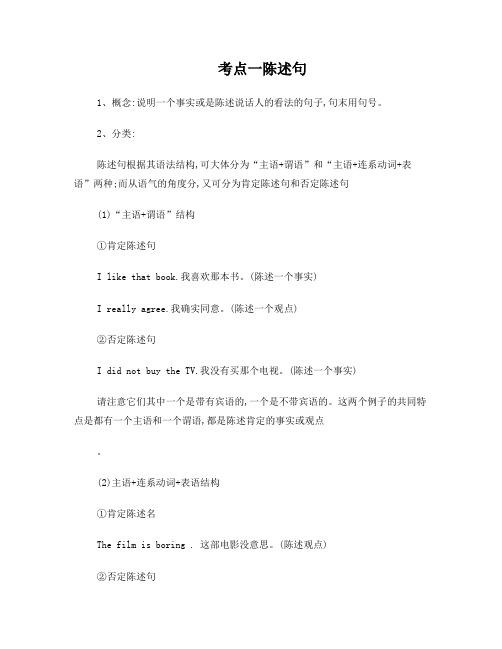
考点一陈述句1、概念:说明一个事实或是陈述说话人的看法的句子,句末用句号。
2、分类:陈述句根据其语法结构,可大体分为“主语+谓语”和“主语+连系动词+表语”两种;而从语气的角度分,又可分为肯定陈述句和否定陈述句(1)“主语+谓语”结构①肯定陈述句I like that book.我喜欢那本书。
(陈述一个事实)I really agree.我确实同意。
(陈述一个观点)②否定陈述句I did not buy the TV.我没有买那个电视。
(陈述一个事实)请注意它们其中一个是带有宾语的,一个是不带宾语的。
这两个例子的共同特点是都有一个主语和一个谓语,都是陈述肯定的事实或观点。
(2)主语+连系动词+表语结构①肯定陈述名The film is boring . 这部电影没意思。
(陈述观点)②否定陈述句Smoking is not good for your health.抽烟对你的健康没有好处。
(陈述一个事实) 3、陈述句的否定结构:陈述句的否定式主要用两种结构来表达:(1)句子的谓语动词为be , have 或者谓语动词有助动词、情态动词时,其否定结构为:主语+谓语动词/助动词/情态动词+ not + 其他成分I am not a teacher. 我不是老师。
We have not (haven`t) any books on animals. 我们没有任何有关动物方面的书。
The children are not (aren`t) playing in the playground. 孩子们没在操场上玩。
He will not (won`t) come. 他不会来。
We must not (mustn`t) forget the past. 我们不能忘记过去。
It could not (couldn`t) be lost. 它不可能丢的。
(2)当句子的谓语动词是do (即行为动词),而且没有助动词或情态动词时,其否定结构为:主语+do (does,did) + not + 动词原形+ 其他成分Y ou do not (don`t) come here every day . 你没有每天都来这里。
语法中的句子类型解析陈述句疑问句感叹句

语法中的句子类型解析陈述句疑问句感叹句语法中的句子类型解析——陈述句、疑问句、感叹句一、陈述句陈述句是表达一个陈述、描写、告知或述说的句子类型。
它是最常见的句子类型之一,我们在日常交流、写作中经常使用。
陈述句的特点是无疑问语气,用来陈述、叙述事实或观点。
陈述句的形式多种多样,可以是以下几种:1. 主 + 谓例:他去了图书馆。
2. 主 + 动 + 宾例:他吃了一个苹果。
3. 主 + 谓 + 宾 + 宾补例:她被选为队长。
4. 主 + 系动词 + 表语例:这座建筑物很高。
陈述句可以使用各种时态和语态,可以通过添加副词、状语或修饰词来增强表达的准确性和丰富性。
二、疑问句疑问句是用来提问的句子类型。
它包含了一些特殊的疑问词,如何、什么、为什么、哪里等,用来询问对方的信息或观点。
疑问句可以分为直接疑问句和间接疑问句两种类型。
1. 直接疑问句直接疑问句通过疑问词开头,用来询问对方的具体信息或观点。
在直接疑问句中,动词通常位于主语之前。
例:你去过哪个城市?2. 间接疑问句间接疑问句是由一个陈述句转化而来,用来表示由陈述句提出的疑问或询问。
在间接疑问句中,动词通常位于主语之后。
例:他告诉我你在哪里。
疑问句的回答方式可以是肯定回答、否定回答、选择回答等。
三、感叹句感叹句是表达强烈情感、感叹、赞叹或惊讶的句子类型。
它常常用来表达兴奋、愤怒、惊喜、失望等情绪。
感叹句的形式有以下几种:1. 独立主格结构这种结构中,名词或代词作为主语,动词作为谓语,没有明确的宾语,用来表达强烈的感叹情感。
例:天哪,这是怎么回事!2. 倒装结构在感叹句中,常用倒装结构来增强感叹的语气,即将助动词或情态动词提到主语之前。
例:多么美丽的风景啊!3. 感叹代词/副词开头感叹代词或副词开头,用来表达惊奇、吃惊或感叹。
例:多么聪明的孩子!感叹句常常使用感叹号表示强烈的情感和感叹。
综上所述,语法中的句子类型有陈述句、疑问句和感叹句。
陈述句用来陈述、描写、告知或述说事实或观点;疑问句用来询问对方的信息或观点;感叹句用来表达强烈的情感、感叹、赞叹或惊讶。
初中英语语法 句子的种类之陈述句

(5)主语+及物动词+宾语+宾语补足语 You'd better tell the students not to make so much noise.你 最好告诉学生们不要这么大声吵闹。 ①带to的不定式作宾语补足语的动词有:tell,ask,order, want等。 ②省略to的不定式作宾语补足语的动词有:feel,hear, see,notice,have/make/let等。
My mother bought me a present. =My mother bought a present for me. 我妈妈给我买了件礼物。
能带双宾语的动词中多数在间接宾语前加to,即动 词+直接宾语+介词to+间接宾语,这样的动词有: give给,pass传递,take拿去,bring 带来 show出示;展现,lend 借给,sell出售 pay 付给, read 读, send 寄给 , tell 告诉 get 使......到达 ,hand 交给, mail 寄给 offer 向......提供 ,owe 归功于,teach 教,write
(2)主语+不及物动词 They are reading. 他们在看书。 (3)主语+及物动词+宾语 I teach English. 我教英语。
(4)主语+及物动词+间接宾语+直接宾语 直接宾语表物,间接宾语表人。一些间接宾语可 改成一个由to引导的短语(强调动作是“向谁”做的), 或由for 引导的短语(强调动作是“为谁”做的)。 He gave me a book. =He gave a book to me. 他给我一本书。
The mother is a doctor.妈妈是一个老师。
连系动词有4类,具体如下: be动词 (am, is, are, was, were) 表状态:be, seem, appear(显得),stand(坐落), stay(保持), lie(位于), keep(保持)
- 1、下载文档前请自行甄别文档内容的完整性,平台不提供额外的编辑、内容补充、找答案等附加服务。
- 2、"仅部分预览"的文档,不可在线预览部分如存在完整性等问题,可反馈申请退款(可完整预览的文档不适用该条件!)。
- 3、如文档侵犯您的权益,请联系客服反馈,我们会尽快为您处理(人工客服工作时间:9:00-18:30)。
一、选择题1.Jane is my friend. ___________ from England.A.she B.he is C.his D.she’s2.--- Mum, there's no milk in the fridge.一Oh; but there ____________ two bottles of apple juice in it.A.are B.isn't C.aren't D.is3.The teachers ________ on the blackboard with chalk in the future.A.isn't writing B.didn't write C.don't write D.won't write 4.My grandma_________ chickens yesterday but she didn’t _______ them this morning. A.feed, fed B.fed, fedC.feed, feed D.fed, feed5.I’m if there are UFOs.(飞碟)A.sure not B.not sureC.not be sure D.sure that6.We __________ buy the train tickets. We can book one by phone now.A.needn’t to B.don’t need toC.need to D.need7.—Don’t forget _____________ the letter on your way home.—OK, I _____________.A.to send; will B.sending; will C.to send; won’t D.sending; won’t 8.If you don’t go to the concert this weekend, ________.A.I will, too. B.I won’t, either.C.I do, too. D.I don’t, either.9.---Excuse me! You can’t smoke here. Look at the sign. It says “NO SMOKING”.---Sorry, I _______ it.A.won’t see B.am going to seeC.didn’t see D.don’t see10.Susan and her classmates__________ to the mountain last week.A.don’t go B.didn’t goC.isn’t going D.aren’t going11.Dave , we will leave in 10 minutes . Are you ready?No , I our guide book and towels yet .A.don’t pack B.didn’t pack C.have packed D.haven’t packed 12.The newspaper came just now. I ________it yet.A.has read B.have read C.hasn’t read D.haven’t re ad 13.The key is yellow .的同义句是:A.The key yellow. B.The is a yellow key .C.This is a yellow key. D.They are yellow key.14.Which of the following sentences is correct?A.He came in and sat down.B.We all like <Harry Potter>.C.When we met. He didn't say hello.D.We went out, headed for the bus stop.15.I______ Jack ______ go to the cinema with you tonight. He always watches films with me. A.think; won'tB.don't think; isC.don't think; willD.think; isn't going to16.—Would you mind _________ in the dining hall?— Of course not.A.Not to smoke B.not smokingC.smoke D.not smoke17.Which of the following sentences(句子)is correct(正确的)?A.It’s very hot in August in most parts of China.B.He always go to work by bus last year.C.Tomorrow is Mary’s 13 bi rthday.D.Tom would like visit some places of interest in Henan.18.---What are you going to do next weekend?---I _____ yet. Do you have any good ideas?A.haven't decided B.won't decideC.have decided D.didn't decide19.We _________ to buy any fruit. There’s enough for the party.A.don’t need B.not need C.doesn’t need D.needn’t 20.You _____buy anything else. We have got everything ready for the party.A.don't need to B.needn't to C.don't need D.need21.-What do you think of the movie The Wandering Earth?-I _________ it yet.A.see B.don't see C.have seen D.haven't seen 22.-Excuse me. I can't enter the museum. Could you help me?-Sorry, the museum __________ today. It will be open tomorrow.A.doesn't open B.hasn't opened C.open D.opens 23.—Isn’t that Ann’s husband over there?—No, it __________be him. He doesn’t wear glasses.A.can’t B.mustn’t C.needn’t D.may not 24.—Daniel, why are you late again? The movie _______ 15 minutes ago!—Sorry, I _____ to. I was trapped (困住) in the subway.A.starts; mean B.started; meantC.started; didn’t mean D.starts; don’t mean25.My mother always tells me that “______”. So I always do my best while studying. A.many hands make light work B.the early bird catches the wormsC.no pain, no gain D.all roads lead to Rome【参考答案】***试卷处理标记,请不要删除一、选择题1.D解析:D【解析】【分析】【详解】句意:简是我的朋友,她来自英国。
考查固定短语和代词辨析题。
前句主语Jane是女生,后句需用女性代词,he和his都是男性,可排除。
be from来自;本句是主系表结构,根据句意结构,可知选D。
2.A解析:A【解析】【详解】句意:——妈妈,冰箱里没有牛奶了。
——哦;但是里面有两瓶苹果汁。
考查there be结构。
there be结构遵循就近原则,two bottles两瓶,系词需用are;but表转折,根据句意语境,可知本句是肯定句,故选A。
3.D解析:D【解析】试题分析:句意:在将来,老师们就不用用粉笔在黑板上写字了。
结合语境可知本句描述的是将来发生的动作,故用一般将来时态,选D。
考点:时态点评:英语中的时态主要是借助于时间状语与上下文语境来进行判断。
解答此类题型,首先要注意句子中的时间状语,如果没有则要通过分析上下文,结合语境来判断句子的时态。
英语疑问句中一般具有时态上的对应关系,注意结合这一特点进行区分。
4.D解析:D【解析】试题分析:句意:昨天我的祖母喂鸡了,但是她今天早晨没有喂鸡。
feed喂,动词原形;fed是动词过去式;根据时间状语yesterday可知第一空应该用一般过去时;第二空didn’t后应该用动词原形,故选D。
考点:考查动词时态。
5.B解析:B【解析】【分析】【详解】试题分析:be not sure +从句表示不确定做某事;本题是if引导的宾语从句。
根据句意:我不确定是否有飞碟。
根据句意故选B考点:考查sure的用法。
6.B解析:B【解析】句意:我们不需要买火车票。
现在我们可以打电话预定了。
need作为情态动词常常用于对must一般疑问句的否定回答,needn’t不必。
作为实意动词,意为“需要”。
need to do sth 需要做某事。
在本句中need作实义动词用,对其否定需要借助助动词do。
所以选B。
7.C解析:C【解析】【详解】句意:---不要忘记在回家的路上寄出那封信。
---好的,我不会忘记的。
此题考查固定短语forget to do sth忘记做某事。
